BREAKING: International Monetary Fund Says Countries Banning Crypto May Not Be Effective Long- Term.

This is a Bullish News coming from the IMF
Recent research by the International Monetary Fund (IMF) suggests that banning crypto assets might not be the most effective long-term solution.
The IMF's Perspective
In a recently released paper, the IMF emphasizes the need to address the drivers of crypto demand rather than implementing outright bans. According to the IMF, understanding citizens' digital payment needs and improving transparency are key factors to consider. The paper further suggests that recording crypto asset transactions in national statistics can aid in evaluating demand and traffic consistently.
The IMF's recommendation is supported by a Chainalysis report, which highlights the significant adoption of cryptocurrencies in Latin American countries such as Brazil, Argentina, Colombia, and Ecuador. These countries rank among the top 20 regions globally in terms of crypto adoption. The report suggests that individuals in these countries are drawn to the benefits that digital assets offer, including protection against uncertain economic conditions, circumvention of capital controls, improved financial inclusion for the unbanked, faster and cheaper payments, and increased competition.
The Case of Argentina
It is worth noting, however, that despite its high crypto adoption rates, Argentina has recently banned crypto purchases through banks. This move raises questions about the effectiveness of such prohibitions. The IMF acknowledges that concerns around financial stability, currency substitution, tax evasion, corruption, and money laundering have influenced the decision to ban #crypto assets in some economies.
The Role of Regulations
While banning crypto assets might be a knee- jerk reaction to perceived risks, regulations can potentially provide a more comprehensive and sustainable solution. The IMF's paper reveals that twelve out of nineteen jurisdictions surveyed in Latin America either have existing regulatory frameworks or are in the process of creating them.
Regulations play a crucial role in mitigating risks associated with cryptocurrencies. By establishing clear guidelines and oversight mechanisms, regulators can ensure that market participants adhere to best practices, reducing the likelihood of illicit activities. Additionally, regulations can foster investor confidence by providing a level playing field and promoting transparency within the digital asset ecosystem.
The Need for International Cooperation
Given the global nature of cryptocurrencies, international cooperation among regulators is essential. Sharing insights, experiences, and best practices can help create a harmonized approach to crypto regulation. Forums such as the Financial Action Task Force (FATF) and the G20 provide platforms for policymakers to collaborate and develop consistent regulatory frameworks that address the risks associated with digital assets.
Balancing Innovation and Risk Mitigation
While it is crucial to address the risks associated with cryptocurrencies, it is equally important to foster innovation in the digital asset space. Striking a balance between risk mitigation and allowing for technological advancements is a delicate task for regulators.
Regulatory frameworks should be designed to encourage responsible innovation, By providing clarity on compliance requirements, regulators can encourage businesses to develop solutions that leverage the benefits of blockchain technology and digital assets while ensuring compliance with existing laws and regulations.
Educating the Public
Another important aspect of effective crypto regulation is public education. As digital assets continue to gain mainstream attention, it is essential to educate individuals about the risks and benefits associated with cryptocurrencies. By promoting financial literacy, regulators can empower individuals to make informed decisions, reducing the potential for fraudulent schemes or uninformed investments.
The Future of Crypto Regulation
As the global regulatory landscape continues to evolve, it is evident that outright bans on crypto assets might not be the most effective long-term solution. Instead, addressing the drivers of crypto demand, implementing robust regulatory frameworks, fostering international cooperation, and promoting public education are key steps toward striking a balance between innovation and risk mitigation.
Regulators must adapt to the rapidly changing digital asset landscape, keeping pace with technological advancements while safeguarding the interests of the public. By embracing a forward-thinking approach to crypto regulation, policymakers can harness the potential of digital assets while manage the associated risks effectively.
39 comments